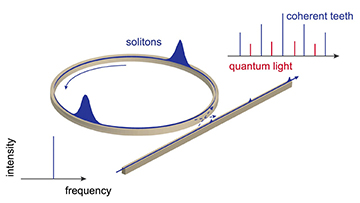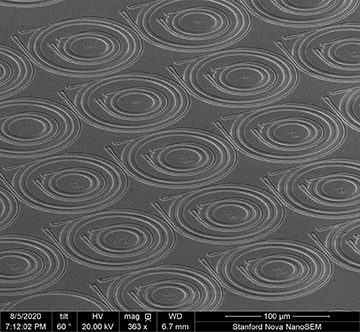A scanning electron microscope image of the silicon carbide microrings. [Image: Vučković Lab] [Enlarge image]
The components of the first frequency combs fit on a lab bench, but today’s miniaturized versions can be integrated into a microchip-scale device. Despite the tiny scale, where quantum effects manifest themselves, most scientists have studied integrated frequency combs in the simpler regime of classical physics.
Recently, a team at a U.S. university has studied the quantum optical properties of the tiny semiconductor instruments, also known as soliton microcombs (Nature Photon., doi:10.1038/s41566-021-00901-z). The researchers found experimental validation for a mathematical model called linearization that describes the formation process of dissipative Kerr solitons, as well as tantalizing evidence of quantum entanglement between microcomb solitons that are created in pairs.
Tiny rings
Multiple research groups have lately worked to shrink frequency combs down to chip scale. A key strategy involves the use of microrings that take advantage of the nonlinear Kerr effect, the variation of refractive index with light’s intensity. One particularly efficient flavor of such microcombs involves resonators that create solitary optical pulses called dissipative Kerr solitons (see “Combs of Light on a Chip,” OPN, January 2021).
Optica Fellow Jelena Vučković and her colleagues at Stanford University, USA, created an array of frequency microcombs using microrings, each roughly 100 μm in diameter, made out of silicon carbide. When the scientists pump laser light into the ring, the light creates a soliton or, if all goes well, a soliton “crystal.”
“In a single soliton state, at any given time, the soliton (pulse) is spatially localized inside the microring,” Vučković and Stanford collaborators Melissa Guidry, Daniil Lukin and Ki Youl Yang wrote in an email to OPN. “For the soliton crystal state, multiple solitons exist inside the microring at a given time with a fixed spatial separation between them.” One can think of the microring as a 1D chain that wraps upon itself in the spatial domain. Solitons that make up the crystal “are locked in a perfect periodic structure via a self-stabilization effect,” according to the team.

Conceptual diagram of the frequency comb and the microring with solitons. The frequency comb diagram shows both the coherent light teeth and the quantum light between those teeth. [Image: Vučković Lab]
To study the quantum properties of these frequency microcombs, Vučković’s group used a new technology called a single-photon optical spectrum analyzer, or SPOSA. This detector combines single-photon sensitivity with a high dynamic range. “Our single-photon detectors allowed us to perform temporal correlation measurements and to see very weak below-threshold light across a wide wavelength range,” the team told OPN. “The high dynamic range allowed us to measure above-threshold and below-threshold light in the same spectrum.”
The group also chose silicon carbide instead of silicon nitride for fabricating the microcombs because the former exhibits less loss than the latter. SiC also has “an outstanding third-order nonlinearity, and excellent compatibilities with future electronic circuits,” the team wrote.
Pleasant surprise
The Stanford researchers next compared their experimental results with a linearization model, designed to tease out the quantum fluctuations. They were pleasantly surprised to find that their experimental results matched the theoretical predictions, which implied entanglement. “The theoretical analysis and experimental results were developed in parallel for this work, and one of the challenges was bringing the theoretical model into harmony with the experimental data,” they wrote.
“We didn’t know for sure that the model was appropriate, as we were measuring the quantum correlations for the first time; a disagreement with the experiment could indicate unexpected physics or just a numerical error,” the team continued. “Upon accounting for all experimental parameters, the theoretical model matched the experiment with just a single free-parameter, which is surprising for this complex system.”
On the cusp of practicality
According to Vučković and her colleagues, the frequency microcomb has been integrated into demonstrations of instruments for lidar, spectroscopy, optical frequency synthesis and optical interconnects. The microcombs are not yet in commercially available lidar systems or data centers, but such products are on the horizon. A Swiss company and scientists at the Swiss Federal Institute of Technology have already announced a fully self-contained “turnkey” soliton microcomb source. The incorporation of these microcombs into lidar and optical communications systems could make future models more energy-efficient, portable and low-cost.
The next step for Vučković’s group is to make experimental measurements of the multimode entanglement that can exist in soliton crystals. To do this, they will measure the “squeezing” of the quantum mechanical noise of the quantum comb, which the researchers say is closely related to the entanglement of the state.
“For some light-based quantum computing algorithms, degree of squeezing is a key resource,” the team wrote to OPN. “In addition to specialized measurement equipment, this study would require specially engineered microring devices to alter the quantum state and efficiently extract most of the light without degrading its squeezing (which is sensitive to loss). We are working on the engineering and theoretical infrastructure, but we are not ready to estimate how long it will take at the present stage.”

